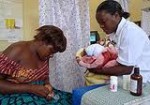 An inexpensive instructional program to teach routine newborn care skills to midwives in Zambia resulted in a substantial reduction in the death rate of infants in the first week of life, according to a study funded by the National Institutes of Health and the Bill and Melinda Gates Foundation.
An inexpensive instructional program to teach routine newborn care skills to midwives in Zambia resulted in a substantial reduction in the death rate of infants in the first week of life, according to a study funded by the National Institutes of Health and the Bill and Melinda Gates Foundation.
The study, published online in Pediatrics, was conducted by researchers in the Eunice Kennedy Shriver National Institute of Child Health and Human Development’s Global Network for Women's and Children's Health Research. "Public health officials and policy makers sometimes assume that only expensive, high tech-care can reduce infant mortality," said Linda Wright, scientific director of the NICHD Global Network for Women's and Children's Health Research. "The results of this study show that infant deaths can be prevented in resource-poor countries when only a modest investment is possible."
Each year, roughly 3.6 million infants die worldwide in the first 28 days of life, with the majority dying in the first seven days after birth, the study authors noted. Roughly 98 percent of these deaths occur in developing countries.
The researchers provided midwives from 18 first level delivery facilities in two Zambian cities with instruction in the World Health Organization's Essential Newborn Care Course. The course covers such newborn care basics as routine cleanliness, newborn resuscitation, keeping infants warm and dry, breast feeding, warning signs of potential problems, and dealing with common illnesses. The first level delivery facilities were small hospitals providing women with short term care — usually overnight — and attendance by a midwife, explained the study's senior author, Waldemar A. Carlo, M.D., a researcher in the department of pediatrics at the University of Alabama at Birmingham.
After completing the course, the midwives taught what they learned to other midwives in the facilities where they worked. In turn, these midwives taught what they had learned to the new mothers in their delivery facilities. The researchers compared the experiences of roughly 20,000 infants born in the delivery facilities before the midwives received newborn care training with the experiences of 20,000 infants born after the training period.
Infant mortality during the first seven days of life dropped from 11.5 for every 1,000 births to 6.8 per 1,000 births. The total cost for the training program was $20,244. The researchers estimated that the program saved 97 lives during the study period, amounting to a cost of $208 per life saved.
The researchers also evaluated the study costs in terms of disability-adjusted life years, a measure used by the World Health Organization to estimate the number of years of healthy life lost to premature death or to ill health. By comparing the number of lives saved as a result of the training to the average life expectancy in Zambia, the researchers estimated that a reduction of one disability-adjusted life year cost $5.24.
The researchers estimated that it would cost $14,128 to maintain the program in the future. This cost would include equipment replacement, training manuals, and salary for the program's two part-time nurses.
An earlier study by the NICHD Global Network for Women's and Children's Health Research found that Essential Newborn Care training for birth attendants in six developing countries reduced the rate of stillbirths by 30 percent.

 A recent report from the World Health Organization showed that life expectancies for women over 50 are increasing around the world. Women are living longer now than they did 40 years ago, thanks to medical advances and more sanitary living. While all countries showed life-expectancy improvements, some improved less than others. The AIDS epidemic in South Africa, the collapse of the Soviet health system in Russia, and the increased cases of lung cancer and diabetes in Mexico are a few instances of slower improvement rates.
A recent report from the World Health Organization showed that life expectancies for women over 50 are increasing around the world. Women are living longer now than they did 40 years ago, thanks to medical advances and more sanitary living. While all countries showed life-expectancy improvements, some improved less than others. The AIDS epidemic in South Africa, the collapse of the Soviet health system in Russia, and the increased cases of lung cancer and diabetes in Mexico are a few instances of slower improvement rates. An inexpensive instructional program to teach routine newborn care skills to midwives in Zambia resulted in a substantial reduction in the death rate of infants in the first week of life, according to a study funded by the National Institutes of Health and the Bill and Melinda Gates Foundation.
An inexpensive instructional program to teach routine newborn care skills to midwives in Zambia resulted in a substantial reduction in the death rate of infants in the first week of life, according to a study funded by the National Institutes of Health and the Bill and Melinda Gates Foundation.